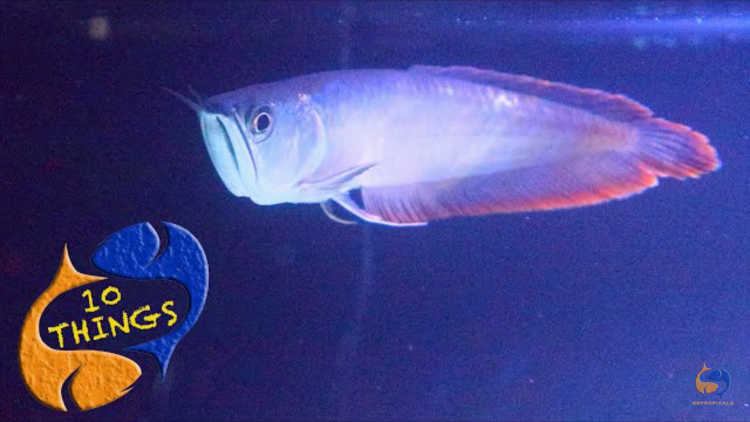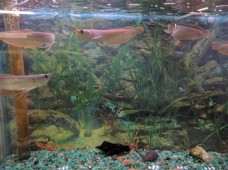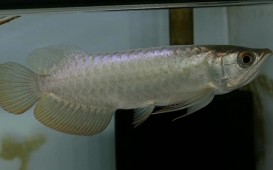-
Home
›
-
Articles
›
-
10 things you should know about Silver Arowana!!
Successfully updated!
10 things you should know about Silver Arowana!!

https://youtu.be/pIRgBwsDaps
-
No Asians Allowed
Silver Arowanas are one of the most amazing fish which have attracted a ton of fish keepers into the aquarium hobby. There are other types of Arowana that people fall in love with at first sight, 'The Asian Arowana.'
The Asian Arowana doesn't get as long as the Silver Arowana, but their appearance is very very similar, their fins and their faces and their mouth all are very similar. But there is one huge difference, and that's the colors. The Asian Arowana is available in several different colors like gold, green and red, which makes them so gorgeous, but there is one big problem with them, they are illegal in the United States.
Back in 1975, the Asian Arowana was listed as endangered, and 183 countries signed a treaty banning the international trade of these gorgeous fish. Our neighbors to the North in Canada can have them because Canada didn't sign the treaty, but for those of us living in one of the 183 countries including the U.S. can buy or own an Asian Arowana. We still have access to some amazing Arowana's like the Silver Arowana and the Scleropages jardinii.
-
Arowana's are Monster
Take a look at the Arowana, it's easy to see why they are so popular. Their super unique shape, a massive scoop for the mouth, and they glide gracefully across the water. They are one of the most graceful fish you' will ever see, but they are a huge problem. They get massive, huge. A lot of the time, you'll find them at your local fish store around 5-6 inches, but be mistaken by that, they are not going to stay that size for long. If properly cared for, Arowana can grow about an inch per month. That 5-6 inch Arowana could be 17-18 inches long only first year after punching them, so make sure you are prepared for that.
In the wild, it is totally normal for several species of Arowana to reach lengths of 4-feet long. In captivity, those same Arowana will get to about 3-feet length. Fish this size should never be kept in an aquarium smaller than 8-feet long. If your tank is smaller than that then you shouldn't plan on getting a fish that can get this long. I know they are hard to resist and they are a super cool looking fish but if you can't provide the proper living environment for them then just stay away from them. The 8-feet long tank is just the minimum, we are also not talking about gallons we are talking aquarium length.
-
Why are Arowana's Called Water Monkeys
Arowanas get the nickname water monkey because they can jump several feet out of the water to snipe insect-off from a low hanging tree branch.
Arowana are huge jumpers. There are plenty of reasons why they would jump out of your aquarium. They could have seen a bug on top of your glass canopy, or it could be that they got spooked by something, something as simple as turning the light on or even somebody walking by the tank real fast, could spook them, whatever it is. It is not a matter of if they are going to jump, its a matter of when will they jump.
So, you have to make sure that you have good, heavy, secure lids on their aquarium because if there is the slightest of the opportunity they could jump out. The lid needs to have to weight to it as they can swim fast and crash into the lid with plenty of force.
-
Daddy's Got Something in its Mouth.
Arowanas are fraternal mouth brooders, which means that the male carries the eggs around in his mouth until they develop into free-swimming fry.
The female lays the eggs. The male fertilizes the eggs, and then he will pick them up and carry them around in his mouth until they can swim around all on their own. Just like with African Cichlids, if you are breeding fish in a large pond, there is always a chance that when the male releases the fry that other fish will try to eat they fry. You can prevent this from happening by moving the male Awowana into a different tank, you can try to catch them once they are removed naturally or by removing the fry from the male's mouth. The problem is that moving an Arowana is not easy and will stress the fish out. Trying to catch the fry is a timing game and the other fish in the tank tend to be faster. Just think about how strong of a jaw a 3-feet long fish has and imagine trying to take your hands and prey its mouth open to get the fray out. This will not be an easy task. These fish are so strong that there are stories of breeders who have cut the male's head off so that they can get to the fry (NOT A SUGGESTED METHOD).
-
What do Arowana Eat?
Arowanas are carnivores, which means they need a meaty high protein diet such as shrimps, fish, and even worms. They can eat all day long but do not let them fool you into overfeeding them. You can feed Arowana a couple of different ways. You can buy store-bought food, or you can get creative and use things like frozen fish or frozen shrimp.
There is another way to feed your Arowana, stew, and that is to buy manufactured fish food for them. You can buy food that is made specifically for carnivores.
It would be best to feed them a variety of foods. Change it up each day to give them a variety of several foods and then rotate them. It's healthier for them and provides different vitamins and allows them to absorbed different foods differently. You do not eat the same thing every day, why would you expect them to. Luckily they are not picky eaters, so you wouldn't have a problem feeding an Arowana. Just make sure to give them quality food to keep them healthy.
-
Water Quality for an Arowana.
Luckily Arowanas are pretty hardy fish, they are not very picky about their water parameters. But there are somethings that you must keep in mind before adding an Arowana to your aquarium.
TEMPERATURE: Arowanas are tropical fish, so they live in warm water, but they don't like it too hot. The ideal temperature is 78 degrees. You want to stay within a 76 - 80 degrees range if you do they will be perfectly fine.
pH: You want to keep your pH around a neutral range, which is a ph of seven; it is all about consistency. Try to stay around seven and try to prevent your ph from fluctuating all the time.
CLEAN WATER: One of the most important things is the water quality. Arowanas have a big appetite. They like to eat A LOT, which means that they create a lot of waste. So you want to keep a consistent maintenance schedule which is crucial for keeping an Arowanas healthy.
-
Wanna Be Besties?
 The number one rule to remember when selecting tank mates for your Arowana is that if it can fit into your Arowana mouth, it's going to be food. Even if you put fish that are too big to fit in the Arowanas mouth at first, the odds are that your Arowana is going to grow a lot faster than whatever you put in there with it. When the Arowana gets big enough and the opportunity arrives you may find that some of their tank makes have disappeared.
The number one rule to remember when selecting tank mates for your Arowana is that if it can fit into your Arowana mouth, it's going to be food. Even if you put fish that are too big to fit in the Arowanas mouth at first, the odds are that your Arowana is going to grow a lot faster than whatever you put in there with it. When the Arowana gets big enough and the opportunity arrives you may find that some of their tank makes have disappeared.
The best tank mate for an Arowana is going to be a larger fish that cannot fit in your Arowana mouth. The best thing is to look for the fish that are going to stay in the middle to lower range of your aquarium. An Arowana will spend most of its time in the top layer of your aquarium. By choosing species that stay away from the top layer will prevent the two from sharing space. You do not want to end up buying expensive fish food (aka Tank Mates) for your Arowanas.
Oscars, Jaguars, Datnoids, Jack Dempsey, and common Plecos should all do fine with Arowanas. One more awesome tank mate for Arowanas is Stingrays, Its prefect because the Arowanas are always going to be on the top, and the Stingray is always going to be in the bottom layer of your aquarium so they never a problem for each other.
-
Where is my Arowana From?
Silver Arowanas originated from several different areas of the Amazon river, but that doesn't even matter anymore. Many of the fish available in the hobby are captive bred in farms all over the world. So, the fish you buy at your local fish store has never seen an Amazon river and have no idea what it is.
They are pre-historic fish that have been in the aquarium hobby for as long a people have been keeping fish in glass boxes. Arowanas are known as tongue fish because they have teeth on their tongue. They are also known for having the two barbells that protrude from the tip of their head above their mouth.
-
Don't Look Down!
There is a common issue with Arowanas that you should be aware of if you are considering getting one of these amazing fish. It's not life-threatening, and it actually has no impact on the fish's overall health, but it is still something unsightly.
The symptoms with drop-by are not as extreme as they sound. If your Arowanas look like they are looking down, and their eyes could be stuck that way.
Arowanas always stay in the top layer of your aquarium. Just like any other fish, they are always hunting for their next pray that will become food. In the wild, they are looking for insects outside of the water, in an aquarium most of the time people are going to throw their food into the tank and it is going to sink down to the bottom, or there is going to be fish and decorations below them that they are looking at.
So, they are not always looking up for food, but they are also going to look down. If there is a lot of activity like food or other fish, a lot of stuff going on below them, they are always going to look down, and that might be what causes the drop-by.
So, when it comes to preventing the drop-by, the keeper should feed floating food and also limit the decoration that is going down below your fish. You can keep the food above the water, allow them to come there and see it up there and then drop it in, and they eat it right away.
It's all to keep them looking up all the time and not down, but if they do end up getting drop-by it's not the end of the world, it's just unsightly it's not going to shorten the fish's life span. The best thing is to try to prevent it altogether.
-
Varieties!
 As mentioned earlier Asian Arowanas are off the limits in the U.S., therefore for in the U.S., you have Silver Arowanas which are popular. There are also the Scleropages jardinii, which looks more similar to the Asian Arowanas. They are shorter and stubbier than the Silver Arowana, but they have the same shape. They have a reputation of being pretty nasty, though.
As mentioned earlier Asian Arowanas are off the limits in the U.S., therefore for in the U.S., you have Silver Arowanas which are popular. There are also the Scleropages jardinii, which looks more similar to the Asian Arowanas. They are shorter and stubbier than the Silver Arowana, but they have the same shape. They have a reputation of being pretty nasty, though.
There is also the black and the blue variety of Silver Arowana, which are also pretty. They have the coloring that is very different from the Silver when they are small. They will show a lot more Black and Blue, but as they grow, they start to look more and more like the Silvers with blue or black highlights in their fins.
There is also albino, and platinum one, which are basically the snow-white of Arowanas, and they are very rare to find. So you have to pay a pretty hefty price if you are lucky to find one.

 The number one rule to remember when selecting tank mates for your Arowana is that if it can fit into your Arowana mouth, it's going to be food. Even if you put fish that are too big to fit in the Arowanas mouth at first, the odds are that your Arowana is going to grow a lot faster than whatever you put in there with it. When the Arowana gets big enough and the opportunity arrives you may find that some of their tank makes have disappeared.
The number one rule to remember when selecting tank mates for your Arowana is that if it can fit into your Arowana mouth, it's going to be food. Even if you put fish that are too big to fit in the Arowanas mouth at first, the odds are that your Arowana is going to grow a lot faster than whatever you put in there with it. When the Arowana gets big enough and the opportunity arrives you may find that some of their tank makes have disappeared. As mentioned earlier Asian Arowanas are off the limits in the U.S., therefore for in the U.S., you have Silver Arowanas which are popular. There are also the Scleropages jardinii, which looks more similar to the Asian Arowanas. They are shorter and stubbier than the Silver Arowana, but they have the same shape. They have a reputation of being pretty nasty, though.
As mentioned earlier Asian Arowanas are off the limits in the U.S., therefore for in the U.S., you have Silver Arowanas which are popular. There are also the Scleropages jardinii, which looks more similar to the Asian Arowanas. They are shorter and stubbier than the Silver Arowana, but they have the same shape. They have a reputation of being pretty nasty, though.





About author